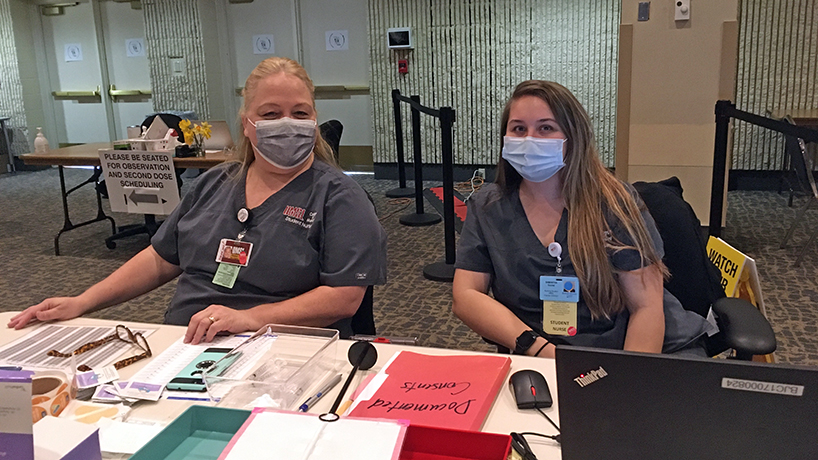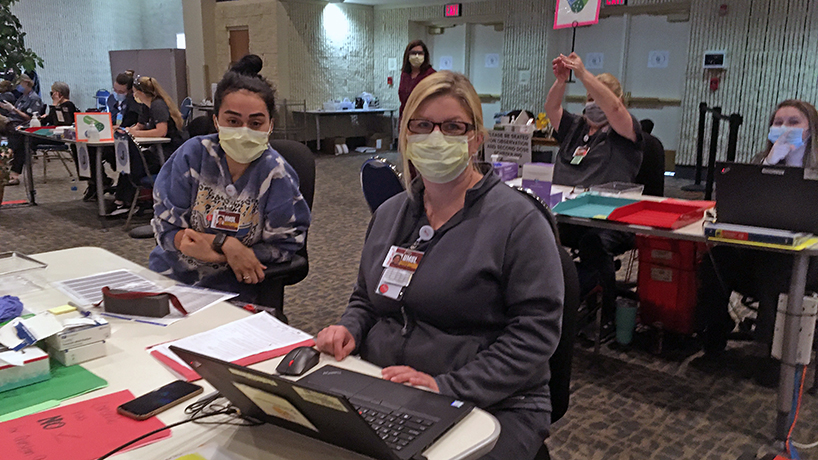
From left: UMSL College of Nursing students Tanya McLaughlin and Sam Gockel are among the 10 student nurses who gave vaccines at Christian Hospital on April 7. (Photos by Jessica Rogen)
The room where vaccinations take place at BJC HealthCare Christian Hospital is large, but not cavernous. It’s nearly empty except for a few clusters of men and women dressed in monotone scrubs.
Included among them are 10 University of Missouri–St. Louis BSN students and one faculty member, Assistant Teaching Professor Beth Dudley, who has brought her eight “Community Health” seniors plus two others.
Then there’s me, a University Marketing and Communications writer along to witness the work that the student nurses are doing to combat the ongoing COVID-19 pandemic.
Impact
Since February, College of Nursing students and faculty have worked six days a week to help vaccinate the greater St. Louis community, a huge coordination effort headed by Director of Clinical Operations and Assistant Teaching Professor Shawne Manies.
The students have worked at BJC sites, with SSM Health, the St. Louis Department of Public Health, the St. Charles Department of Public Health, pop-up event sponsored by CHIPS, at Veterans Affairs sites and at mass events located at UMSL and held in concert with the St. Louis County Department of Public Health and the Missouri National Guard.
During that time, they’ve filled over 832 positions and given more than 25,000 vaccines. As a result, the American Association of Colleges of Nursing recognized the UMSL College of Nursing as one of only 350 COVID responsive schools across the United States.
The importance of those efforts cannot be overstated.
“I am extraordinarily proud,” said Roxanne Vandermause, interim dean of the College of Nursing. “Our faculty and staff rose to the challenge of this pandemic in a heroic fashion. The students had to learn all of the precautions and recommendations from the CDC and our national leaders, then use that information to educate the citizenry and also to educate themselves so that they could be part of the health care that was needed.
“They’re taking on an additional load, as is the faculty. That has required a great deal of resilience and a true dedication to the health of the region.”
Student nurses have been screening individuals for symptoms, working in testing sites in St. Louis and beyond and caring for patients on COVID floors.
But while they have impacted the health of the region, the students themselves are equally affected, which is why I’m here for the 7 a.m. shift to witness their experiences.
Few have said it better than Romina Shayesteh, one of the seniors on site.
“If I could put someone in my shoes, or in another nurse’s shoes, to see what we have to deal with and what we have to see, I would give them that opportunity,” she said. “I just want them to see how it’s actually affecting people.
“They might not know someone that got sick and got hospitalized, but there are people out there that are actually suffering from COVID, getting the hospitalized, literally suffocating to the point where they have to get ventilated or end up dying because their lungs aren’t expanding the way that they should. I wish that people understood our side of the story.”
All the UMSL BSN students such as Romina Shayesteh (left) and Pam Bantle have completed at least three shifts this semester administering vaccines.
A full day
The eight-hour vaccination shift begins as BJC HealthCare Clinical Nurse Manager Nicole Jennings checks in with the UMSL group to give an overview of how the day will go. It turns out not to be necessary as everyone has already worked a shift at Christian Hospital – one of at least three that every single BSN student did this semester.
But I take it all in. The room is split in thirds. On one side is the entry area, where patients are checked in and then funneled to the vaccination area in the center.
There are two rows of five tables. Each has two seats – one space for a vaccinator and another for a scribe, the documenter who enters the information from the patient consent form into the computer system and compares that to the scheduled appointments.
Jennings tells the student nurses that they’ll be situated at the tables at the back of the room, like last time. Dudley will float among them to answer questions, deal with problems and fetch vaccine doses from the pharmacy table at the front of the room.
The tables without the student nurses won’t have a scribe, so there will also be two runners who pick up consent forms and pass them on so that the patient information gets entered.
Dudley gives me this role, and so I spend my time walking up and down the aisle, chatting with the nurses and passing forms along to UMSL student nurses Pam Bantle and Sam Gockel so that those receiving their first vaccination can be quickly booked for a second shot while in the post-shot waiting area that comprises the last third of the room.
Thankfully, it isn’t technical work, and I often find myself grabbing forms as soon as they land in their folders.
“You’re slacking,” jokes the nurse at the table closest to the front of the room when I get back after a break and find three forms waiting for me.
Meanwhile, Shayesteh and Tanya McLaughlin give vaccinations, changing gloves and wiping down the chair and table with disinfectant between patients. They’re masked up and wearing face shields or safety goggles, which are the desirable choice for comfort.
“It was giving me a headache last time, and I actually cut all of this foam off,” Bantle said, gesturing to the thick pad that runs across the forehead support.
Aside from a mid-morning break to snag one of the donuts donated by a grateful community member and lunch, they rarely leave the table.
“We rotate breaks,” Bantle said. “But if you have vaccines leftover, you never leave them unattended.”
The four have the system down. That’s necessary since the day will see 880 vaccinations plus any add-ons. McLaughlin declares that she’d like to beat her vaccination number from last time.
“I think last time I did about 80, and I’d like to get to 100,” she said. “Only because – I don’t know – I like to set goals, and it makes my day go faster.”
The vaccination doses are given with retractable needles. Dudley holds one up to demonstrate to me how the needle shoots back into the barrel of the syringe after injection. The relatively new technology has eliminated needlestick injuries, a common occurrence with old-school syringes that needed to be manually capped.
I get a novel glimpse into what’s surely the mundanities of nursing as Shayesteh comments that a patient who bled after injection must be on blood thinners.
Stories
From left: BJC HealthCare Clinical Nurse Manager Nicole Jennings and Assistant Teaching Professor Beth Dudley talk during the April 7 event.
All four students are seniors, poised to graduate in May with jobs lined up. Shayesteh will be in intensive care unit step down, Gockel in an orthopedic unit, McLaughlin in the operating room and Bantle in the ICU.
They all feel their educations have been impacted by the pandemic and the necessity to move from in-person classes to online. Shayesteh describes it as “culture shock.” Bantle, whose clinical preceptor doesn’t have enough hours to fulfill her graduation requirement, has been at the vaccination clinics frequently.
McLaughlin and Gockel felt dread when they heard they’d be doing hours of vaccinations – afraid it would be tedious or disorganized. But that quickly changed during their first shift.
“Everyone there is so happy to be getting this vaccine,” Gockel said. “They’re so positive, and they’re so thankful for us, and I think that’s also why I like it. I like hearing their stories because they just want to talk. Who knows, this could be the first time they’ve gotten out of the house since who knows when.”
“Sam and I are both people persons,” McLaughlin agrees. “That’s a big part of nursing that gets overlooked. A lot of times people need more than just their meds.”
The two have an infectious energy that starts with Gockel’s enthusiastic waving to demonstrate that they are open and ends with people lingering at their table post-shot to talk.
“I’m with the happy group,” declares one patient. “I want this group. That means I won’t have any problems.”
Part of the experience of vaccinating has been listening to patients’ stories and witnessing the emotional reaction that often accompanies the shot. The student nurses have had people come from as far as Kansas City or Cape Girardeau for appointments or show up hours in advance in anticipation.
One of Shayesteh’s patients tears up as she receives the vaccine.
“I am grateful that I was having the opportunity to be able to vaccinate people,” Shayesteh said. “It just feels good because people are terrified – I can’t even imagine – like the elderly, having to not leave their homes and not being able to see their family members because they’re so scared that they might get sick and end up in the hospital and dying.”
History
Shayesteh fought her way through a relatively mild case of COVID, experiencing headaches and tiredness, then received a vaccine. An immigrant from Iran at age 6, coronavirus is the second epidemic she’s lived through, tuberculosis being the first.
They’ve all had some complicating factor in their lives that has made a difficult year even more challenging to juggle. For Gockel and McLaughlin, that’s been family responsibilities.
McLaughlin is a nontraditional student. She didn’t finish high school, earned her GED and started community college before dropping out to get married and have children.
“About nine years ago was the perfect storm of events,” she said. “My mother got esophageal cancer, and my youngest child was diagnosed with a connective tissue disorder, a genetic disorder. When he was diagnosed, it was like, ‘Oh, that’s what’s going on with his sister.’”
Going through that meant hours of research and speaking with doctors. Along the way, McLaughlin discovered she enjoyed the medical world and liked taking care of people, so she decided to pursue a nursing career.
Gockel, on the other hand, has wanted to be a “baby doctor” since she was a little kid herself, eventually falling in love with nursing after taking a CNA course in high school. Like McLaughlin, she’s shouldering family responsibility and has been raising her 11-year-old nephew while working and studying since her sister passed.
“Life throws you curveballs, and you just kind of go with it,” she said. “I take one curveball at a time.”
That’s undeniably true for all four – and all the UMSL BSN students – who have persevered despite unprecedented circumstances.
















